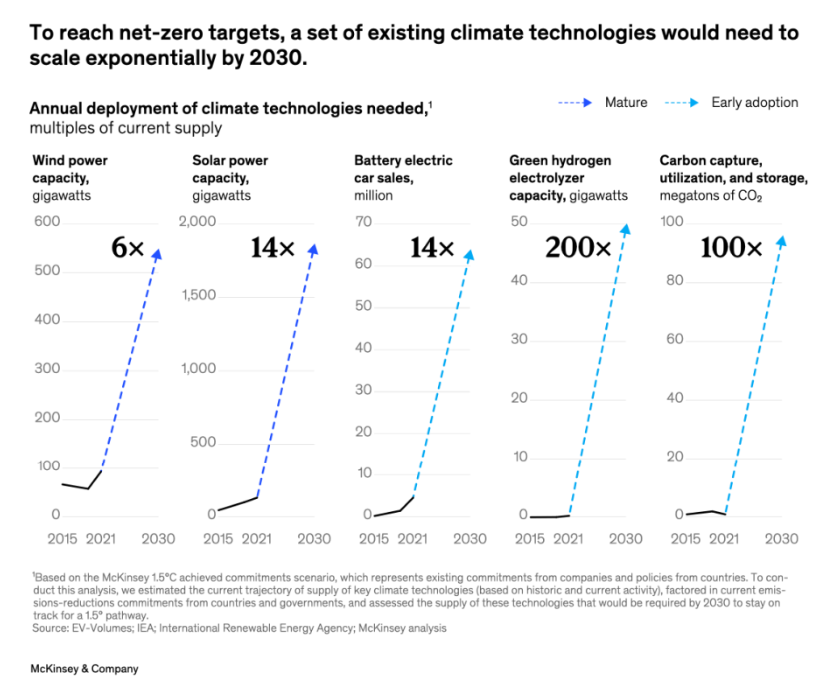

Stellantis is a major, global car manufacturer. And its CEO is not a yes-man, Carlos Tavares’ career is proof of this. Having pulled out of the European car manufacturers’ association, ACEA, one of his key messages is that imposing electric vehicles (EV) in new sales in Europe in 2035 is putting the cart before the horse, the horse being the supply of low-carbon electricity and the deployment of ubiquitous recharging infrastructures. Both are clearly lagging behind, in spite of the vast amounts of public money poured into these two prerequisites, supplied by taxpayers who may not purchase an EV for a long time and may consider these investments a wrongful use of their taxes, electromobility not being a common good or service, as can be a road network, education or health services, for instance. But the sheer effort needed to grow renewable electricity production is immense, as can be seen in this McKinsey graph, even within a short-term horizon like 2030:

And these efforts must be borne, at least strongly helped, by governments, as market forces alone cannot find justification to invest in the energy transition. Low-carbon technologies are not lowest-cost, their obsolescence, from a climate regulation point of view, may come before investments have been recouped. On top of that, energy security, highlighted by the war in Ukraine, clearly is a responsibility of governments. Will they find the financial resources to fund the effort, especially in the renewed context of higher inflation, higher interest rates, leading to an increased, unbearable possibly, public debt level?
Back to the cart before the horse. When ideology guides regulation, such nonsense happens. But, sooner or later, reality strikes back. It takes a drought to realize hydropower capacity can drop, a change in transatlantic weather patterns to realize wind can be absent for days, years of nuclear energy bashing to realize technical expertise has evaporated and put nuclear plants at risk of corrosion issues, it takes a war in Ukraine to realize interconnections between European countries is not that reliable. In front of these threats to renewable or low-carbon energy production, demand flourishes, driven by the growing decarbonization requirements, in transport, housing, industry. To give an example, replacing blast furnaces by direct ore reduction in electric ovens in Arcelor Mittal steel plant in Dunkirk, in the north of France, would make this industrial site the largest single electricity user in France.
So, the low-tone music of low-carbon electricity supply-demand imbalance is getting louder, and played by singers with a larger audience. On a continent with a culture of industrial policy, at least until the rise of the neo-liberal creed half a century ago, concepts like “hierarchy of usage” or “quotas” arise. Or comparisons between the impacts of sectoral strategies. In early April 2023, the French ministry of industry asked the 50 top CO2 emitting industrial sites (11% of national emissions, 60% of industry emissions) to present decarbonization strategies, with awesome ambitions (44% reduction in 2030, 80% in 2050). Should these quite costly ambitions materialize, the minister declared they would be equivalent to electrifying 10 million cars, more than one quarter of the pool. In terms of enforcement, dealing with a handful of big companies, like Arcelor Mittal, Exxon or TotalEnergies, is much easier than convincing millions of motorists. And decarbonizing the industry means more jobs (biomass supply, CO2 ducts, hydrogen- or electricity-driven new equipment), when switching car manufacturing to EV means less jobs.
Regulation-wise, if technology neutrality was a cornerstone of climate regulation, directing renewable electricity according to a hierarchy of usage, based on criteria like greenhouse gas (GHG) emission reduction performance, industrial performance as an energy vector or facilitator, difficulty to substitute to a fossil resource or effort focus, for instance, would not be that difficult to design. In France, the national strategy for biomass mobilization defines in the law such priorities, in extenso and by declining order, food, bio-fertilization, bio-materials, bio-molecules, liquid biofuels, gaseous biofuels, renewable heat and electricity. Such a hierarchy is based on key concepts like cascading and resource use efficiency, still recognizing that these bio-products belong to sectors that are not necessarily connected, serving markets with different scales, drivers and maturities. Alas, the energy transition in Europe institutions is plagued by ideology and lobbying, which does not bode well for the proper allocation of low-carbon electricity in face of a ballooning demand.
Finally, we start realizing we have a synchronization issue, low-carbon electricity capacity growth not building up quickly enough to meet growing demand from all sectors that have to decarbonize, sooner than later. Bearing in mind the trend to relocate energy issues at national level, it would not be surprising EU Member States, also USA States for that matter, make their own decisions with regards to future supply and demand balance of low-carbon electricity, based on local advantages and electoral priorities, rather than ideological prejudices or misconceptions.
Philippe Marchand is a Bioenergy Steering Committee Member of the European Technology and Innovation Platform (ETIP).